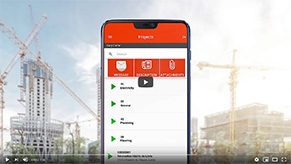
1 June, 2022
Mobile-Punch
SHARE
How to protect against unexpected increases in building material costs?
The cost of building materials has risen considerably in the past two years. The construction industry was severely affected by the Covid-19 pandemic, and the austerity of current global events creates further instability in the market. The lumber industry, for example, is experiencing an unprecedented price increase.
Information published by the NASDAQ states that the cost of lumber has more than doubled when comparing it to pre-pandemic values (source). Lumber price reached its peak on May 7, 2021, when 1,000 board feet were valued at $ 1670.50 (source). Supply chain issues and general insecurity in the market will keep affecting these prices throughout 2022.
When looking at the cost of steel, one can see a similar story. While the price of steel in 2022 has dropped in relation to 2021, its price remains higher than it’s been in the last ten years (source). The last time steel prices reached current numbers was back in 2011 when the floods in Queensland impacted raw material prices on a global scale (source).
Instability in the housing market and other fields critical to the success of the construction industry has also been impacted by military activity in Ukraine. According to the Canadian Construction Association, construction costs will most likely increase in 2022, as the rising price of oil and other commodities may have a harsh effect on inflation (source).
6 ways to mitigate construction material costs
Here are 6 ways to mitigate the increase in construction material costs:
- Assemble a solid team
- Implement project management software
- Diversify your material options
- Optimize the material acquisition process
- Include an escalation clause in contracts
- Adopt lean construction practices
1. Assemble a solid team
A construction project requires the diverse set of skills of an expert team. Besides contractors, industrial, and residential projects require the expertise of architects, engineers, and interior designers. Bigger projects may also require cost estimators, landscape architects, construction managers, and other specialists.
The better a project team works together, the more efficient the construction process will be. Teams that operate at a higher efficiency save on overall costs. To guarantee solid team synergy, a project team should be assembled during the early stages of development.
When architects and contractors work hand-in-hand, they can devise more streamlined strategies and schedules. In addition, if a team communicates well, the need for expensive and time-consuming redesigns can be mitigated. A concise plan of action guarantees that effective use of resources will be implemented, saving on construction material costs.
2. Implement project management software
Bad project planning is a significant driver of issues in a construction project. Poor initial planning may be directly responsible for the failure of a project. Even plans that incorporate the experience and expertise of the labor force may contain oversights. Mistakes and delays can diminish the efficiency of operations and have an impact on a team’s capability of acquiring the construction materials it needs.
Thanks to recent advancements in technology, digital alternatives to traditional project management techniques have begun to emerge. Software solutions can be used to manage projects and optimize resource planning. Mobile-Punch’s planning tools offer an all-in-one software solution ideal for businesses in the construction industry.
A centralized data approach built into the software ensures all staff can communicate in real-time, leading to constant awareness of project development processes. Both face-to-face and long-distance project management techniques are supported by Mobile-Punch, making the software effective for operations of all types and sizes. Thanks to instant reporting tools, managers can access crucial information about operations at any time.
3. Diversify your material options
It is possible to avoid high construction material costs by opting for alternative materials. This strategy allows a company to remain in business without relying on materials that are expensive or hard to obtain. Expanding material options helps limit material waste, reduces labor costs, and streamlines the delivery of projects.
Alternate materials of interest include:
- Pre-cast concrete
- Ready-mix concrete
- DensGlass
- Zip-board
- Alternative wood species
- Prefabricated wall panels
- Framing systems
Naturally, it is important to commit to a standard of safety, quality, durability, and functionality. The substitute materials being used should satisfy all regulatory requirements. Architects and engineers should strive to incorporate new materials into their work without compromising its integrity.
4. Optimize the material acquisition process
Sometimes alternative materials are not good enough. Due to this, construction project teams should have reliable sources for all essential materials. To guarantee the best material prices, all essential commodities should be acquired in advance to reduce pricing and availability risks.
Buying materials early allows leaders to increase their decision-making power throughout the development of the project and generally results in cost savings. In addition, it protects against future scarcity. A project that has to stop in the middle of operations due to a lack of materials is a considerable liability for every party involved in the construction process.
5. Include escalation clauses in contracts
To protect their businesses from a building material price increase, many contractors decide to implement a force majeure clause in their contracts. This sort of clause is meant to limit the responsibilities of a contractor regarding a rise in the price of construction materials caused by extraordinary events beyond the control of any signing party. However, it is highly unlikely that the terms of a fixed-price contract can be changed due to a force majeure clause.
To legally protect themselves, companies can include escalation clauses when redacting a contract. Also known as changed circumstances, equitable adjustment, or cost plus clauses, these legal strategies are designed to help contractors circumvent volatile job costs by transferring those expenses to the consumer.
An escalation clause should specify which particular building materials are at risk of causing issues and let the consumer know that a future rise in their price could affect the final price of the project. In addition, it should be stipulated how price changes will be communicated and under what conditions the escalation clause will be triggered.
There are three types of common escalation clause triggers to consider:
- Invoice method: This type of escalation clause trigger uses an invoice or other written note from the supplier to certify that the price of commodities has risen.
- Index method: In this case, the escalation clause is triggered due to changes in a price index guide. This can be particularly useful when working with suppliers who do not provide fixed-price quotes until the time of the transaction. Because price indexes are regional, this method may leave a contractor vulnerable to fluctuations in local markets.
- Certified bid cost: This type of escalation trigger combines the previous two approaches. Raw material prices must be estimated and disclosed by the contractor, using index price listings and supplier prices as a basis for calculations. This amount will be added to the contract as a certified bid cost.When the time comes to buy the materials, the escalation clause will trigger if the actual cost exceeds the agreed certified bid cost. If this happens, the price increase will be added to the contract price.
6. Adopt lean construction practices
Lean thinking is a decision-making process meant to improve the quality of work. This current of thought can be better understood byr reading the seven lean principles:
- Optimizing the whole: From raw materials to critical business data, all the functions and assets of a business should be made to work to their fullest. This is a challenge a company can overcome by building a solid infrastructure based on reliable communication channels and an alignment toward common goals.
- Eliminating waste: In lean business development, waste is any feature or detail of a project for which a customer wouldn’t willingly pay. For instance, a project may be riddled with extra details the customer will end up ignoring, bloating budgets while adding no value.
- Building quality into the system: To build a system that promotes growth, one must error-proof by automating as many processes as possible. Tasks that are tedious, repetitive, and highly prone to human error should be delegated to specialized AI whenever possible. This approach allows the skills, effort, and energy of the workforce to be spent performing more productive activities.
For instance, mobile punching software can replace traditional punching cards with a much more methodical approach and simplify timesheet management, scheduling, project tracking, and more. This way of doing things can save you 10% in labor costs and 50% in the time spent managing timesheets.
- Managing flow to deliver fast: A company’s labor has no real value until its products or services have reached consumers. Therefore, it is in the best interest of a business to deliver results as fast as operational efficiency allows. Organizations should value and reward fast deliveries and should try to avoid overburdening themselves with too many tasks.
- Creating knowledge: Many companies have grassroots beginnings, operating on a homegrown business model and relying on empirical knowledge to devise new strategies. While this business method can work during the early life of a company, it will not sustain progressive growth.
To grow sustainably, organizations must design, document, and continuously improve their processes to increase their speed and efficiency. Talent retention should be a priority and employees should be motivated to grow, share, and cross-train.
- Deferring commitment: The time at which a company makes a crucial decision can have a drastic effect on how choices develop into actions. Organizations should strive to make decisions at the last responsible moment. By doing so, the decision-making process will be benefitted, as access to the most up-to-date information will be available.
- Respecting people: A lean approach to business requires the hiring and retaining of the most qualified personnel. Without fundamental respect for all members of the labor force, it is impossible to expect them to be motivated and efficient at work. Lean organizations create environments where leaders understand the needs of both their customers and their employees.
New technological trends in construction
Save time and money with Mobile-Punch
Mobile-Punch is an all-in-one time management and productivity platform. This novel platform is designed to provide business leaders with real-time actionable insights related to working schedules, the distribution of tasks, and many other areas of project management. The platform’s functionality allows users to manage and customize their labor force from the app. With Mobile-Punch, having to deal with complicated timesheets, schedules, and other project management documents is a thing of the past.






